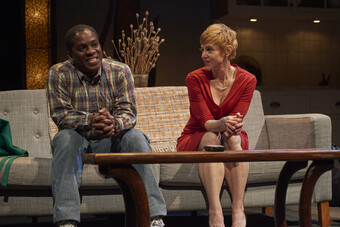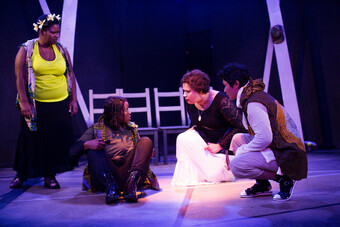Video Games as an Art Form Part 3
Bringing Games to Life
What can theatre artists learn from gamers? How do you effectively incorporate technology in a video game turned theatre performance? This series addresses audience engagement in theatre and gaming, and the need for relevance in theatre to the gaming generation by looking at the process behind an innovative show in San Antonio, Texas.
As a kid I watched a terrible game show with a memorable segment at the end; the show would use [now outdated] special effects technology to put players inside a video game. It wasn’t well done, but the idea rattled around in my head for almost two decades before I said “I can do that better.” That live-action video game is Heroes Must Die.
In April 2016, I collaborated with Northwest Vista College to produce Heroes Must Die at their Palmetto Center for the Arts. The show followed the story of the video game, and created the game world through incredible props, puppetry, and even dungeon-style sets, while letting the audience interact in game-like ways that changed outcomes.
Before we begin, keep in mind two things:
- The world of games would be created with kuroko stagehands, the black-clad “ninja” wielding props, puppets, even video game User Interface items like character health.
- The show was audience-interactive, with the audience holding paddles that represented “buttons” on a controller that they would raise to make votes and control the characters, changing the course of the story.
This show was risky and experimental, but required a budget to create the props, costumes, and sets needed to fully realize a video game world. The university came through by having a progressive and creative vision to give students a chance to do a unique, original, challenging new show.
Pre-Production
There were three extremely difficult aspects of setting up a show like this. First was scheduling because video games are notorious for having difficult-to-guess schedules. Even the biggest AAA companies often release games years later. And of course theatre schedules must be planned a year in advance. So I planned the dumbest, most stressful, most impossible combination of media imaginable.
Fortunately, the head of the producing theatre, the incredible Mellissa Marlowe (of Northwest Vista College, the San Antonio Theatre Coalition, and more) was willing to reschedule the show after we missed our initial deadline. Then, we compromised on our end by having a beta ready before the show. It wasn’t a fully polished game, but the whole story was playable, so any interested early players could get the full experience.
The second challenge was facilities. This show was risky and experimental, but required a budget to create the props, costumes, and sets needed to fully realize a video game world. The university came through by having a progressive and creative vision to give students a chance to do a unique, original, challenging new show. They also had a new scene shop, and the facilities to build some wild stuff. Let this be a lesson in the importance of building relationships and being a good collaborator.
Finally, there was the script that needed to build off the world of the video game, but offer a new story that is accessible to those who had ever played the game, while still offering something for those that had. I brought back all the main characters (even one who died), and it was fun to see how they had grown. I also decided to make a new protagonist for the show so we could not only see how the world progressed after the game, but also view it from a new perspective, which I think helped bridge the stories. At the end of the game, the heroes toppled the villain, but were left with a fractured empire to run. The show picks up with the challenges of them trying to run a stable kingdom. While it ties in to the game, it was a self-contained conflict and rolled along smoothly on its own.

Production—Tech
The tech needs of this show were phenomenally wonderful and silly and difficult. On the mundane end, the costumes were designed by the director (Mellissa), and created by two seamstresses. I provided her with the game art and it was exciting to see the influence of the character art on the costumes. Most notably, we hired a prop armor maker to do custom armor, molding and painting foam to create some fantastic getups.
Props also provided a fun challenge because we had very few everyday items actors needed to hold. Everything was either at an absurd scale (such as the giant, five-foot swords used as weaponry), workable puppetry (such as the dragons our heroes fight), or did not exist as an object, but as a magical or meta-narrative effect. This includes fireballs and lightning bolts thrown by characters, health bars and quest markers, and traps and movable scenery. Fortunately, Richard Solis, our talented prop-maker, was a video game fan and had the game art for reference, and understood what we wanted. He was able to make lightweight, easily-wieldable props; he also made colorful 2D designs so monsters and magic could be summoned at a moment’s notice.
Finally, there was the set. Some pieces were straightforward to build, but modeled on the environment art in the game. Some were nothing new (a bar set), but had to be moved on and off stage with alacrity. Even with the complicated pulley system for the flats and a massive stage area, we still used every square inch of available space to move props and sets on and off as scene changes dictated.
But how can we forget the magnum opus, “Skullcrusher Mountain”? From the get-go, I had this vision of a real-life dungeon delve where the characters went through a platformer-style video game level, moving up and down different levels while dodging traps, and activating puzzles. I pitched a Donkey-Kong style scaffold with several levels and ladders in-between; we worked together to figure out some fun mechanics (the appearance of a lowering drawbridge and a moving, floating platform). With a few back-and-forths on design, the builders created a thirty-foot wide, three-story monster of a set on which more than half a dozen actors could move in simultaneously to create the montage.

Absurdism is about facing a world in which nothing seems to make sense… It is about the embracing the fact that our lives can be both terrifying and ridiculous, indeed the more terrifying, the more ridiculous. And it is about resistance.
Tech—Choreography
There were two final levels of insanity with this show—the choreography and the audience interaction.
Now, the fight scenes were difficult enough—I had to direct the actors in safely swinging giant swords, and work with six to ten fighters in some scenes. But the special-effects-wielding kuruko made another challenge.
Every fight scene not only had complex sword work, but also characters throwing magic spells that were imagined as real life (and of course moved by a stagehand); characters flying through the air (lifted by stagehands); puppeteers guiding monsters into the fray; health bars going up and down in response to all this—it was a cacophony of movement. And remember, some of this action was happening three stories in the air.
Finally, there were the audience interactions. We narrowed down my plans to two main interactions. The first was a straightforward vote. Using a projection screen that lowered and showed a display, the audience was given two options—press A for the hero to win, or B for the villain to win. The audience held up their buttons to indicate their vote. An onstage presence (sometimes the protagonist, sometimes a stagehand) would do a quick visual tally, indicate which decision was the majority to the audience and our sound techs. Next, the actors proceeded with the appropriate result, which meant they had to know two storylines at all moments.
The second interaction was a video-game challenge. We divided the audience into three sections based on seating arrangement, then flashed a map of the seating area, a button assigned to each seat, on the screen. Audience members in each area saw the button line up with them, and had to hold it up. If all sections did so in time, the audience succeeded and the story went one way, but if they failed, the story went another way.
Post-Production
Fortunately, the interactions panned out exactly as I planned. Audiences understood enough to make a good effort at it and succeed often, but it was challenging when they sometimes failed, leaving things interesting. Not every audience member had every button, which led to people briefly and passionately interacting with their neighbors to try to help them with the challenge or influence their vote. Thus, creating a shared experience.
The choreography happened with no one getting hurt, and when it shined, it shined. There was something magical about seeing this purely fantastic display of unreal action unfolding, and still maintain suspension of disbelief. And damn, that dungeon set.
The show was well attended, the cast and crew had a wonderful time, and I was eternally grateful for the support to make something like this happen. I’m left with a great hope that young (and old) theatre artists are inspired by this and try something new themselves. Whether it’s hyper-stylized visuals borrowed from video games, new uses of technology, or new ways of thinking about audience involvement, I would feel good if some new ideas sprang from this. Go forth and create.











Comments
The article is just the start of the conversation—we want to know what you think about this subject, too! HowlRound is a space for knowledge-sharing, and we welcome spirited, thoughtful, and on-topic dialogue. Find our full comments policy here
This is project sounds like it provided a lot of risks but in the end really paid off. Integrating audience participation into a video game inspired play is absolutely brilliant. When first reading about it I began to worry about the multiple story lines that could form from giving audience control of the story and how memorizing all those gateways would be an immense challenge to the crew and actors. By giving a simple choice of either letting A) the hero win or B) the villain win I can see how it eliminates the possibility of a multiple complex story arches. I really love how you married the elements of video games and theater together. A very inspiring and fresh concept!